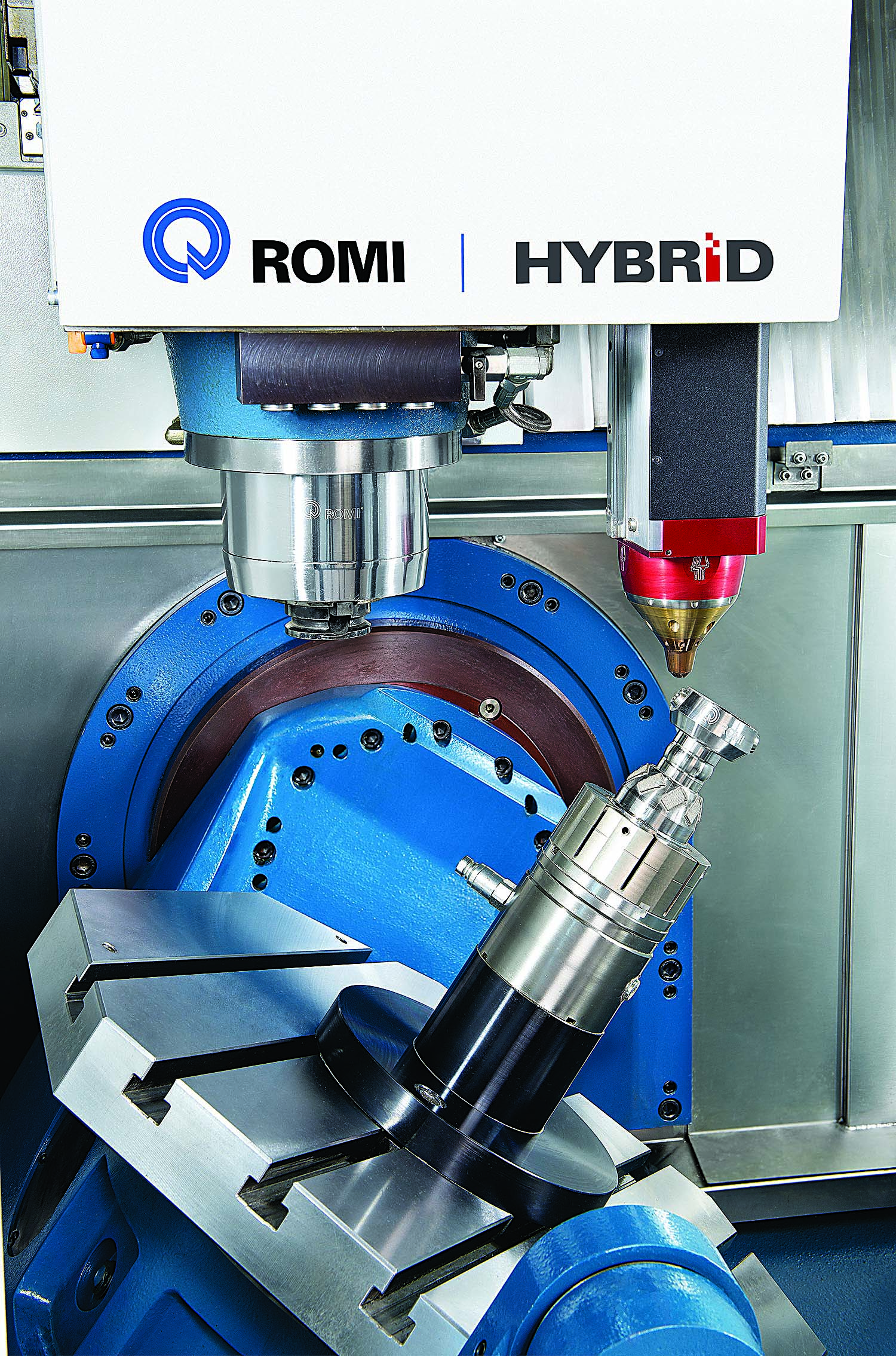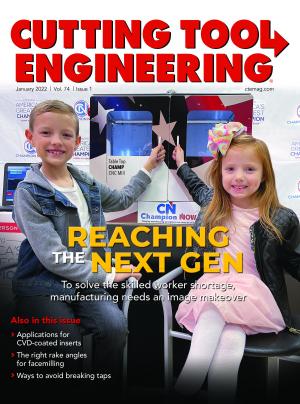A vertical machining center enhanced with multiple additive manufacturing options can open the door to the creation of novel products and improve the process of repairing old ones.
That was the thinking behind the design of the DCM 620-5X hybrid five-axis VMC introduced by Romi Machine Tools Ltd. in Erlanger, Kentucky. The VMC is one of Romi Machine Tools’ hybrid manufacturing machine tools that combines traditional subtractive machining operations with 3D metallic additive manufacturing.
By engaging the machine’s three linear axes and the tilting (b) and rotating (c) axes, users can simultaneously machine parts on all five axes. Included are linear roller guides for the x-, y- and z-axes and direct rotary encoders for the b- and c-axes. This combination reduces vibration and produces high rigidity and precision, according to the company.

The DCM 620-5X hybrid five-axis VMC combines conventional machining capabilities with an additive manufacturing system. Image courtesy of Romi Machine Tools
Built on a Romi-made monoblock base, the DCM 620-5X hybrid also comes with a 40 big-plus taper direct-drive spindle capable of 15 to 15,000 rpm, a 24-hp motor, a 24"×20"×18.1" (x, y and z) table, a Siemens Sinumerik 840D sl CNC with a 19" touch screen, and a 30-tool automatic tool changer.
The ATC plays a key role in the machine’s additive manufacturing system.
“Every CNC machine moves between different cutting tools,” said Jason Jones, CEO of Hybrid Manufacturing Technologies LLC in McKinney, Texas, which developed the additive system. “In our system, we wanted that same flexibility to do other types of processes besides just cutting.”
So the ATC can hold a number of different heads for 3D printing, as well as heads for inspection. During a manufacturing process, each of these can be used as needed, just like the individual cutting tools in the tool changer.
“You could have three or four different sizes and styles of heads doing additive and inspection,” Jones said. “That is completely unique.”
The system can deposit any weldable metal powders or wire. Once the ATC brings an additive head into position, a supply unit connects with the head, and the additive process begins. Called laser metal deposition, the process merges metal with a laser beam in the air and applies the metal to a machined workpiece in the desired location. If the 3D-printed surface is too rough to meet application requirements, the ATC can bring in a cutting tool to produce the necessary finish.
The DCM 620-5X hybrid is used mainly in the aerospace, medical, and mold and die industries, said Rafael Boldorini, general manager of Romi Machine Tools. Typical applications include part repair, adding features to a workpiece or component, and intricate work in situations in which conventional subtractive manufacturing takes more time and produces more wasted material. To minimize material costs, the 3D printing system adds expensive materials, such as Inconel and stainless steel, in the exact amount required to produce the desired profile.
As an example of what can be created with the hybrid machine, Jones described a machined cast-iron tooling insert that was edged with a metal matrix composite using the additive system. A blend of metal and ceramic, the composite provides excellent wear performance.
“By adding that hard edge just around where (the insert) wears out,” he said, “we go for a three times lifetime improvement.”
Jones also said adding the hard edge to the insert cost only $13 more and took just 10 minutes longer than the CNC machining process, with no additional setup time required for the additive operation.
As for restoration, he cited the example of a metal gear with three teeth in need of repair. In this case, the machine added material to build the teeth back up and then finished the job with a machining operation.
“The teeth as printed usually don’t quite match the tolerance that you need for a gear, so being able to come in and finish it in the same setup is superhelpful,” Jones said.
Sometimes, repairing parts with the hybrid machine can give users other ideas of what can be done.
When repairing a steel gear, for example, “they don’t have to put back steel when they’re depositing,” Jones said. “They can put down something more exotic just where it wears out, and they end up with a better product than they had to start with. And as soon as they make that realization, they start to make new products like that.”
Contact Details
Related Glossary Terms
- computer numerical control ( CNC)
computer numerical control ( CNC)
Microprocessor-based controller dedicated to a machine tool that permits the creation or modification of parts. Programmed numerical control activates the machine’s servos and spindle drives and controls the various machining operations. See DNC, direct numerical control; NC, numerical control.
- machining center
machining center
CNC machine tool capable of drilling, reaming, tapping, milling and boring. Normally comes with an automatic toolchanger. See automatic toolchanger.
- tolerance
tolerance
Minimum and maximum amount a workpiece dimension is allowed to vary from a set standard and still be acceptable.


